 |
|---|
“You Know Maude, I Think It May Be Time to Move to Costa Rica” |
Broken News:
Note: This month's Broken News section is longer than normal because I kept running across interesting tidbits I couldn't resist writing about - mea culpa - GG
Slippery Scheckles
In our August 2011 edition, our crack news team (but alas, still unrewarded by the Pulitzer committee) reported the introduction of new 1,000 and 2,000 colone bills by the government in an article called Money Changers. Well, as a result of those changes, it seems that we should have one more change.
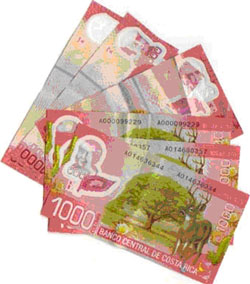 |
|---|
Slippery Scheckles |
After using the new notes for several months now, most people are reporting that handling the pretty pink 1,000 colone bills is a pain in the purse.
The problem is they're made of a wholly plastic material that is so slippery that some people are starting to call them teflon bills. The government prefers to call them "polymer" but listen Tico dudes, as someone with two degrees in Chemical Engineering and 14 years experience in the plastics and polymer industry, there's no practical difference between the two for a layman. Plastic is plastic, amigos.
Our hero acts as treasurer for a local social group and routinely handles bills of all denominations including the 1,000's. These damn pinkies will not stack without a heavy weight on them and often pop out of a pocket, a wallet, or off the end of a table.
The 1,000's also suffer from a propensity to "creep", a property peculiar to plastics, which simply means that they distort under a constant force and tend to hold their new shape after deformation, like when folded into a pocket or wallet. Unfolding them is always a fun game as they return to their original flat shape only after a great deal of effort. The new 2,000 note on the other hand acts more normally. It's texture is different and appears to have more fiber in the polymer mix.
So, Banco Centro de Costa Rica dudes, change this creepy money one more time and reformulate the 1,000's using the "polymer" mixture of the 2,000's. Don't worry if they have the same texture as the 2,000's, there still will be a difference in length (the 1's are 7mm or about 1/4 inch less in length than the 2's), a difference in color (pink versus blue) and a difference in the big number on each bill (see Dorothy, this is a 1,000 note, it has a 1, comma, zero, zero, zero...over here we have a 2,000 note, see it has a 2 where the 1 was...).
For a complete listing and description of Costa Rican money go here: Money
¡Pura Vida!
Shaking in the Rain
Most of us have heard over the years that earthquakes occur when the tectonic plates (Earth's crust floating on it's molten core) of one region clash and grind into those of another region. When this happens, a fault is created and when the two plates slip, one over the other, friction and tension are released via shaking, rattling and rolling. Costa Rica, for example, rests on the "Pacific Rim" fault line and regularly experiences "tremblors" of varying magnitude.
Now, the latest news is that some folks at the University of Miami recently released a report of a study which looked at tremors with a magnitude over 6.0 Richter in Taiwan and Haiti, two very seismically active areas. They concluded there is a causal link between very heavy rain periods and subsequent earthquakes The research group leader, Professor Shimon Wdowski of the Marine Geology Department, summarized it this way:.
“Very wet rain events are the trigger. The heavy rain induces thousands of landslides and severe erosion, which removes ground material from the Earth’s surface, releasing the stress load and encouraging movement along faults.” Furthermore, the Prof and his slaves (er, graduate students) found a strong time correlation, i.e., the rain brings on the quakes in the first four years after the rain event. The following examples were cited:
| Rain Event | Quake Event | |||
|---|---|---|---|---|
Year |
Place |
Event |
Year |
Richter Magnitude |
1969 |
Taiwan |
Typhoon Flossie |
1972 |
6.2 |
1996 |
Taiwan |
Typhoon Herb |
1998 |
6.2 |
2009 |
Taiwan |
Morakot Typhoon |
2009 |
6.2 |
2009 |
Taiwan |
Morakot Typhoon |
2010 |
6.4 |
2010 |
Haiti |
Two Hurricanes + Two Tropical Storms in 25 Days |
2010 |
7.0 |
Of course, what came to my mind immediately were the torrential tropical storms that hit our area in 2010 that caused flooding, power outages, road damage and resulted in hundreds of people being evacuated, The June 1, 2010 horrendous storm that virtually brought Manuel Antonio, Quepos, Parrita and other areas to a halt for days and, in some cases weeks, was accompanied by a 6.2 earthquake that was our hero's strongest tremor experience to date. In that case I believe (correct me if I'm wrong), the tremor preceded the rain storm by about one week but I don't recall how much rain occurred before the major storm hit.. (Story here: SHAKIN AND SWIMMING)
So far this year the rain in the Quepos/Manuel Antonio area has been normal, maybe even a little below normal and tremor activity minor. So far I've felt only occasional, very mild vibrations (one becomes sensitive to even a miniscule vibration when living on the Pacific Rim). On the other hand, quake activity in the north region of the country, where rains have been more severe this year, is considerably more active although, thank the Almighty, the tremors have been in the range of 2.8 to 3.8 and nothing close to a 6. Remember the Richter scale is geometric and 6.0 signifies 1,000 times more energy release than a 3.0 and a 7.0 (Haiti) is 10 times more powerful than a 6.0.
So maybe the Prof and his academia dudes have something going here. More will be revealed as the U. Miami group plans further studies.
A recent exposition at the National Museum honored a local photographer named Francisco Coto whose 50 year career cataloged much of Costa Rica's modern history.
 |
Coto was born in 1924 in Alejuela and began his career in 1942 at the age of 18 using a 127mm German camera. Since the modern Costa Rican Republic began in 1949 with the establishment of the constitution, Coto has seen the entire development of the republic. Among his famous photographs was a shot of JFK during his three day visit to Costa Rica in March of 1963 (right). |
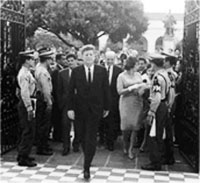 |
|---|---|---|
87 Year Old Francisco Coto With Some of His Early Cameras |
1963 Photo by Coto of JFK Leaving the Teatro Nacional (Dean Rusk in Background) |
Good work and salud amigo.
One of the things that had been floating around the halls of government in San José for several years was the idea of a new tax on corporations. The idea was first proposed in 2006 by the administration of Oscar Arias, the predecessor to our current lady president, Laura Chinchilla. Arias and Chinchilla are in the same political party, the PLN (Parotid de Liberación Nacional).
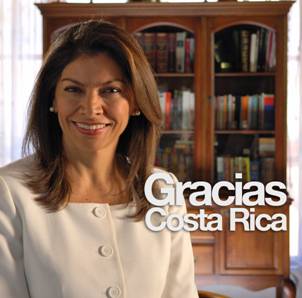 |
|---|
La Presidenta - Laura Chinchilla |
I'm not sure how passing more and more taxes relates to liberation, but "La Presidenta" was the one that finally got the new tax law passed by the General Assembly. She signed it into law in late December just before the Christmas recess. Merry Christmas all you corp owners.
The annual tax is set at 1/2 the amount of the "base" monthly salary of a certain level of clerk in the justice department (whatever). This rate is set by the government and becomes the equivalent of the minimum wage. I have read somewhere that between 60 and 80% of all workers in Costa Rica receive this base wage/salary.
The base wage rate at the time the law was passed was 316,200 colones per month or about $622. This rate is adjusted upward by the government two times per year, in January and mid-year.
Ah, but these bureaucrats are clever. Linking the new tax to the wage rate puts the government in control of both and guarantees an automatic increase in the tax every year. And there's no sunset provision in the law as far as I can determine.
Sure enough, within a couple of weeks of La Presidenta signing the bill into law, the following press report came out:
"When the president signed the bill, the base salary was 316,200 colons or about $622. So the tax on corporations, which is expected to go into force April 1 would have been $311. However, some increase was expected because salaries usually are increased every Jan. 1 and July 1.
But a 14 percent hike was not expected. The Consejo Superior del Poder Judicial approved the increase, which will take effect Jan. 1. The new base salary is 360,600 colons or about $709. That means the corporate tax will be $354.50 or 180,000 colons when it takes effect April 1." from AM Costa Rica - December 29, 2011"
Of course, if the tax were to increase at 14% per year each year, it would nearly double in five years.
At first it seems that this is simply a nuisance tax, but I interviewed a few people and found some interesting information. An owner of several rental properties here told me he has six or seven corporations. Several of them were acquired with the properties. It's not unusual for people here to have several corporations; it's a way to separate the assets and make transfer of ownership easier on sales as well as provide more protection in the case of unexpected legal action. A real estate owner with several rental properties told me he has as many as 9 corporations, the owner of a small hotel told me he also has multiple corporations as did a pizzeria owner.
So annual tax bills for many could be in the range of several thousands of rather than hundreds of dollars. Also, some people, such as lawyers, inventory as many as 200 to 300 corporations to have them available in order to more quickly help individuals do what they have to do and avoid the bureaucratic maize that is Costa Rica government. If you have 200 corporations, even at the half standard rate for inactive corps, the bill could come to more than $35,000. (Can't really see this happening - I suspect the legal beagles are already drafting legislation for the Assemblea to exempt themselves).
When I first came to Costa Rica someone told me one way to get my own telephone without having a residency permit (cédula) was to form a corporation as the phone company (ICE) would not open an account on a passport only. Excuse me, to get a telephone line one could use a corporation; the boys in the stores downtown will sell as many phones as you want but you can't activate them without an ICE account.and that would require a cédula or a corporation. Unlike the States; the stores don't activate lines.
Back then I asked around and got quotes from lawyers to form a corporation that ranged from $300 to $600. I thought this a little expensive on top of the $200 3G phone I bought here (my Blackberry from the States was one of the models that would not work with the ICE system even though it was less than one year old when I got here). Fortunately, a couple of friends offered me telephone shelter under their corporation and I've been paying the monthly bill under their name ever since. Had I formed the corporation I presume I would now be subject to the new tax. Kinda increases your monthly bill a bit, doesn't it?
Some people keep an inventory of inactive corporation around just in case they need them for something new. The new law also provides for a 50% reduction in the tax for an "inactive" corporation. But if you want to get rid of an inactive corp all together, the estimate is that it will take $300-600 just to "decorporatize" an inactive corp to avoid the half tax.
I've started three different corporations in two states in the U.S. and it never cost me over $50 because I did it myself. It isn't that complicated and a lawyer is not required in the U.S. although here I wouldn't want to try it without one. In Florida you can do it online (myflorida.gov) in a matter of minutes.
I think it's stuff like this that earned Costa Rica the 125th position out of 183 in the recent World Bank country ranking for ease of doing business (more on that here: Rank Ranking).
Identification Please
Recently the U.S. Federal Government began lawsuits against several states questioning the rights of local law enforsement agencies to check the legal status of individuals who have been stopped for suspected violations. About the same time the following news tidbit was published in a local electronic newspaper:
"The Fuerza Pública said that it checked out a number of entertainment clubs over the weekend and ended up detaining 26 persons. Police checked out about 1,600 persons and confiscated marijuana, crack and cocaine, they said.
Of the 26 persons detained, 14 were held as illegal immigrants." (My emphasis - GG)
Evidently the Costa Rican government, one of the most tolerant in the world, doesn't think asking the question "Where are you from dudel let's see your papers?" to be politically incorrect.
I know I've been stopped here twice over the years, both times while driving at a slightly excessive speed (slightly, really - watch that speed trap north of Jacó amigos) and asked to produce my passport. Each time, after the officer checked my valid passport and visa stamp I was sent on my way with a warning. I have never been stopped in the street for identification but I routinely carry a photocopy of my passport in my wallet just in case. The copy also is handy for certain transactions. In some other transactions however, (bank, ICE) the original passport may be asked for, prompting me to scurry back to the ranch to get it.
 |
|---|
But Amigos, I Really Meant to Renew My Work Permit |
One of the fastest ways to get deported from Costa Rica is to be found working without a vaild work permit. It can also happen with an expired cédula (residency permit). The process for obtaining a cédula was changed last year to add a $200 "deposit" ( see Seeking the Cedula) that is intended to be used in the event one is later deported. They'll kick you out and you get to pre-pay for the privilege. I suspect the excuse for this tax was that in the past some deportees were penniless and it cost the government money to kick them out.
I'm surprised the kick-out fee wasn't as least as large as the new corp tax, say $350 or more (maybe next year). I doubt $200 would pay for a first class exit - sounds more like a bus, a banana boat or Air Gallo Pinto to me.
Tourist Prayer
At this time of year, the "high season" in Costa Rica, we may all want to stop what we are doing, pause a moment and meditate on the Tourist Prayer:
THE TOURIST PRAYER
"Heavenly Father, look down on us, your humble, obedient tourist servants who are doomed to travel this earth taking photographs, mailing postcards, buying souvenirs and walking around in drip-dry underwear.
We beseech you, oh Lord, to see that our plane is not hijacked, our luggage is not lost and our overweight baggage goes unnoticed.
Protect us from surly and unscrupulous taxi drivers,
avaricious porters and unlicensed English-speaking guides.
Give us divine guidance in the selection of hotels, that we may find our reservations honored, rooms made up, and hot water running from the faucets. We pray that the telephones work, the operators speak our tongue, and that there is no mail waiting from our children which would force us to
cancel the rest of our trip.
Lead us, dear Lord, to good, inexpensive restaurants where the food is superb, the waiters friendly, and the wine included in the price of the meal.
Give us the wisdom to tip correctly in currencies we do not understand. Forgive us for undertipping out of ignorance and overtipping out of fear.
Make the natives love us for what we are and not for what we can contribute to their worldly goods.
Grant us the strength to visit the museums, the cathedrals, the palaces and the castles listed as musts in the guidebooks.
And if perchance we skip a historic monument to take a nap after lunch, have mercy on us, for our flesh is weak.
Husbands: Dear God, keep our wives from reckless shopping and protect them from “bargains” they don’t need and can’t afford. Lead them not into temptation, for they know not what they do.
Wives: Almighty God, keep our husbands from looking at foreign women and comparing them with us. Save them from making fools of themselves in cafes and nightclubs. Above all, please do not forgive them their trespasses, for they know exactly what they do.
All together: And when our voyage is over, and we return to our loved ones, grant us the favor of finding someone who will look at our home movies and listen to our stories so our lives as tourists will not have been in vain.
This we ask you in the name of Conrad Hilton and American Express. Amen."
Amen and Pura Vida!
Choo Choo Chiquita
(History of the Railroad in Costa Rica)
I thought it might be interesting to do a little research on the history of railroads in Costa Rica having heard by word of mouth that the original railroad was built to carry bananas from the banana country east of San José to the caribbean ports, particularly Limon. That was not quite correct but in doing the research I hadn't realized until now how intertwined indeed are the developmental histories of the brown coffee bean, the yellow fruit and the iron horse in Costa Rica.
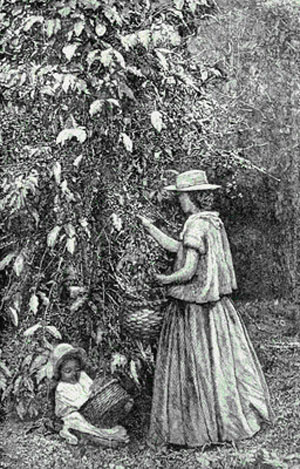 |
|---|
Picking Coffee in the Late 1800's |
Coffee came first. By the early 1800's in Costa Rica, three hundred years after Columbus first landed here on his last of four trips to the new world, the population had reached about 60,000 (currently 4,579,000) and the coffee plant had been well ensconced in the central and eastern highlands.
Coffee flourished in the rich, volcanic soils of the mountain foothills. By 1820 the first exports of coffee had been recorded and the country quickly became well recognized as a source of good product for the rapidly growing world demand for the dark beverage.
As the industry developed into a major industry and exports grew over the next 50 years, it became obvious that a railroad was needed to carry the beans from the coffee growing regions to the caribbean side in order to reach U.S. and European markets more easily. There would need to be a new port as well, both for the shipping of the beans and the receipt of materials to build the railroad.
Remember, the Panama Canal didn't open until 1914 and in the late 1800's the Pacific town of Puntarenas was the only shipping port in the country, requiring a long trip around the horn of South America to reach U.S. and European markets..
In 1871 control of the rail project was awarded by the government to Henry Meiggs, a well-known gringo promoter, adventurer and developer who had a rather checkered background in questionable investment projects. One of his early endeavors had been the development of a commercially unsuccessful dock on the wrong side of San Francisco that eventually became known as Fishermen's Wharf. He left a trail of unpaid debt behind him from that and other projects that he was only able to repay in his latter years, which he actually did do.
Meiggs, however, had achieved some success building railroads in South America, enough to impress the Costa Rican government. After being chosen by the Costa Rican President to build the Alejuela-Limon railroad, Meiggs in turn appointed his nephew, Minor C. Kieth to oversee the project in Costa Rica. Meiggs would later also be an owner and operator of steamships that serviced coffee and banana exports through the new port. Entrepreneurs in those days became mini-conglomerates over night.
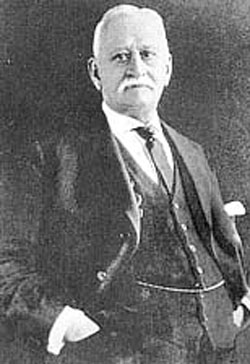 |
|---|
Minor Keith, the Project Manager for the East/West Costa Rican Railroad |
Clearing of land for the construction of a dock began in the sleepy fishing village of Puerto Limon on the caribbean coast the same year as the start of the railroad. The journey of 147 kilometers (88 miles) from Alejuela took 12 days and the initial operation to clear the site for the dock was based at a tent camp.
An interesting tidbit of history is the fact that the workers who were to construct the dock were required to travel by burro from San José to Limon and each had to personally carry 70 lbs of foodstuffs in order to survive as there were only thick forests and jungles between the two points.
The planned rail route would run from what is now the western San José suburb of Alejuela to Limon on the eastern caribbean coast. Construction would proceed from both ends towards meeting somewhere in the middle, although the thicker jungles on the eastern end would make construction there much slower. The construction began in 1871 and it was over a year later before the first one mile section from Limon to the west was completed.
The 12 miles from Alejuela to San José were completed within three years but the entire railroad would not be finished until 1890, nineteen years after construction began. The project, much like the Panama Canal, would take a heavy toll in lives with over 5,000 deaths from malaria and other disease, 4,000 of them from the first 25 miles on the eastern leg. (Deaths resulting from the construction of the Panama Canal were estimated at over 27,000 - mostly during the early French construction period). After the initial losses on the Costa Rican project, many replacements were recruited from Jamaica which gave birth to the distinct caribbean culture still prevalent on the east coast of Costa Rica today.
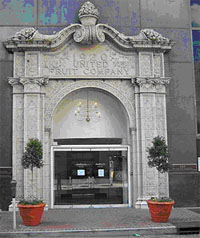 |
|---|
The United Fruit Entrance to Their Building in New Orleans Has a Facade Dating Back to 1920 |
As the construction proceeded, Mieggs and Keith looked for ways to better supply their workers with food and they hit upon the idea of planting fast-growing bananas on some of the land the government had given them as part of the project deal and which bordered the rail route .
Again the richness of the soil eventually proliferated the plants and the gardens grew into plantations. By the time the railroad was completed, banana production was so great as to suggest exports. Meiggs shipped some to New Orleans on one of his owned steamers where they were very well received. He then formed an import/export company that later merged with another company to become the United Fruit Company.
By the early 1900's, Costa Rican banana exports exceeded those of coffee and the railroad was routinely used to carry coffee, bananas, freight and people west to east and freight and people east to west. Both banana and coffee industries flourished. Costa Rica continues to be a major exporter of both products today.
A couple of years ago I had a conversation with a visiting gentleman who used to be a manager for the United Fruit operation here in Quepos. He explained to me that Quepos was originally formed as a town for the benefit of United Fruit Company workers. Physically it was formed by blowing up parts of the two mountains north and south of the current city and filling in the swamp that was between them. Because the town is actually below sea level, it was completed by building the dyke that currently exists by the bay (called the "malecón"). Ironically, the road on top of the dyke currently is the site of the weekly Feria, a place where you can still buy fresh locally grown bananas and a myriad of other fruits and vegetables.
 |
|---|
Banana Flower in Full Bloom |
My friend also said that United Fruit conducted successful banana operations here until the 1940's when a blight devastated local plantations. In response, many of the plantations were converted to the African Palm plantations we see up and down the coast today, the product of which is an oil. The nuts from these palm trees can be processed into a valuable palm oil used in lotions, beauty products and food additives. In addition to yielding a valuable product, palm oil trees are much less susceptible to blight.
United Fruit operated the palm plantations until 1995 when the operations were sold to a group of private investors that named their new company Palma Tica. United Fruit went through buyouts, mergers and acquisitions over the years (including a bankruptcy) and eventually evolved into the company we know today as Chiquita, actually Chiquita Brands International, a $5 Billion food conglomerate.
From slipping on one banana peel along a railroad track to realizing a major industry in a few decades, the history of the railroad pioneers in Costa Rica couldn't be more interesting. The coffee and bananas produced here are still among the finest in the world.
¡Pura Vida!
Languid in Language
In the February 2009 edition of the Golden Gringo Chronicles, only the 7th in the series and the fifth month I had been resident here, I made the following statement:
"As I see it, I have some advantages in learning the language: (1) an ability to mimic sounds easily (I’ve been a verbal copy-cat since high school), (2) a pretty good grounding in Latin from four years at a parochial high school - there is a great similarity in regular verb conjugation for the two languages, and (3) a smattering of French from living in Brussels, again where there are some similarities in words, although not often enough and too often with different endings."
 |
|---|
My Spanish Teacher at Work - Oh No, Sorry Jorge, That's a Clown Seen In Downtown Quepos Entertaining Some Kids |
When I reflected on this recently, it brought to mind a time when our hero worked for a certain vice-president of a major corporation some 30 years ago. This fellow was one of the best judges of people I've ever met. He used to irritate the hell out of me because I would make a presentation I thought pithy and perceptive and list my conclusions. Several times over the 14 years that we worked together his response would be: " I agree with the logic Bob, but not the conclusion".
He would have loved to hear me admit that the statement above concerning my expected language ability falls into the category, that it seemed logical but it didn't work out that way.
What I didn't include in the bravado statement above is the fact that I also took 60 hours of Spanish in Brussels in 1975. I was slated by my company to go to Spain to help start up a joint venture with a Spanish company but the deal fell through and I switched to French for the last 40 hours of the program.
Basically, after three years here, I have reached about the same level of proficiency in Spanish that I achieved in French in less than two years taking lessons in Brussels.
I attribute the difference in the rate of progress to two factors (more logic):
 |
|---|
Sometimes It's Just About Being Tonguetied |
First, an inability to absorb and remember information now that I'm in my sixties, that I could much more easily retain at age 31 when I lived abroad. Now I have a hell of a time remembering where I put my keys or wallet, let alone what the subjunctive conjugation of "I'm going" is ('vaya" - I looked it up).
Secondly, I'm having more difficulty in distinguishing sounds due to both an aging ear and a tendency in the local dialect to slur words together. The ability to mimic doesn't always bring meaning as I had hoped. I am adept at using excellent pronunciation on the wrong sentence structure.
With regard to the last point, it is true (more opinion yet) that the local Ticos do run their words together rapidly with a minimum of mouth movement. We do the same in English of course. Waddayagonnadoaboutdat?
Whatever your native language, it's easy to slip into muttering phrases that are colloquialisms or otherwise annotated. Proper enunciation and correct grammar require exercising the mouth muscles much more than what we want to do naturally and are not necessary when we're talking with people in our native habitat.
But our hero has no plans to give up. Actually I have made progress on the language basics and just the other day I found myself comprehending about 50% of a conversation between two Ticos. It's coming slower than expected but it is coming. ¡Ojala! que lo sigua. (I hope it continues).
¡Pura Vida!
Chi-Chi-Chicharrones
I seem to recall that in a previous life (i.e., the married one) that pork became central in at least one of the meals around the beginning of the New Year. In our house it was a pork loin with sauerkraut - I guess it's a Polish/German/ Irish thing.
It's the same here in Costa Rica. It seems that Ticos love pork at any time of year, but at New Year's especially. I had a hard time finding bacon, let alone pork loins, two days before New Year's as the cases were being emptied of pork products. No pig in the vicinity was safe as butchering a fresh kill for a family outing is de rigueur for some here.
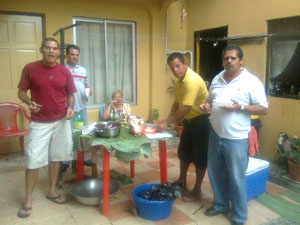 |
|---|
The Madrigal Family and Friends Gather While the Cook Begins Dismantling the Pig |
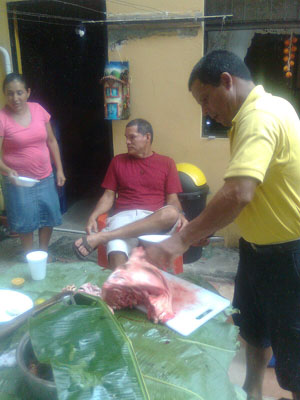 |
Never Argue with a Chef Who is Wielding a Machete - Yes Dorothy, That's The Head With Snout He's Chopping Up |
So, on New Year;s Eve Day, my landlord and his family threw a party to which I was invited as the token gringo. In addition to the family, there was the captain and crew of my landlady's commercial fishing boat. The boat's cook served as the chef at the party. Also, assorted friends of theirs stopped by periodically to wish a happy new year and sample the food.
The format was roughly equivalent to a gringo barbecue except the center of attention was a large case containing a whole, chilled pig that had been cleaned, quartered and the head separated. We were going to have chicharrones, one of the time-honored traditional ways of preparing pork here.
The process is simple. Fire up a large cast iron pot (they used propane gas and a large burner) containing several inches of oil. While the oil is heating to very hot, the chef is busy chopping up the quarters into small pieces that are good for two or three bites each. The skin is left on and, except for the very lean parts, the bone is left in. They are eaten much like chicken wings.
No part of the pig is unused. Eventually the head was chopped into pieces (the cook uses a machete throughout the process) and the tongue removed for cooking. On one cooked batch I even saw the pig-tail which I referred to as the "culo". This brought howls of laughter as this term, which is technically correct for the "bottom" of a person or animal, is more commonly used here to refer to the anus.
Batches of cooked chicharrones are transferred to a large bowl in the center of the table where folks can pick at them. The pieces are crisp and take a few minutes to cool down. Sprinkled with a little salt or garlic powder and splashed with a little limone juice, the taste is delicious. Accompaniments included a fresh salsa and boiled or fried plantains.
This is basic Tico eating at it's best amigos. Originally a Mexican dish, Ticos have adopted chichirones as their own and they become an acquired taste for a gringo, sort of like Gallo Pinto.
The first batch of chicharrones produced by my host's chef were not impressive. I found them about 90% fat. If you like pork rinds, which I don't, you would like these fatty ones when fried crisp. The second batch was decidedly better, about half meat and half fat. The latter batches were about 80% meat and 20% fat but they had been fried crisp and were delicious. I commented that, in my opinion, each batch was getting better. My hosts nodded and smiled as if that had been the strategy all along.
Now I wasn't a virgin to chicharrones at the recent cookout; I have enjoyed them a number of times over the years. I first encountered them on my second visit to Costa Rica back in 2003. And I've never had them fresher than they were that day. More on the 2003 experience here: Chicharrones.
Instead of saying bon appetite, the Ticos say ¡buen provecho!
What's-in-a-Word
Body Parts Confused
It seems to me the Spanish language has a couple of body parts confused. The common word for both a finger and a toe is "dedo". You have to understand the context in which it's being used to know whether you're talking about the appendages on your hand or your foot. Or maybe English is just a little more specific, I dunno.
If a teacher would ask a student in school here "¿Cuanto dedos tiene?" (How many digits do you have?), the typical Tico student would answer "20". Of course there is always an exception to the rule as we reported recently concerning a Cuban fellow who would have to answer differently. They call him Twenty Four.
This is the word in Spanish for tongue twister, you know, like "Peter Piper picked a peck of pickled peppers". Spanish has it's own set of tongue twisters. Here's one I came across recently:
| "Si yo como como como, y tú comes como comes, ¿cómo comes como como, si yo como como como?" |
... which, literally translated, means ... | "If I eat as I eat and you eat as you eat, why do you eat as I eat, if I eat as I eat?" |
|---|
Como is both a word meaning "like" or "as" and also is the first person present form of the verb "comer", to eat.
Dude. Bet this trabalengua wasn't quoted much on New Year's Eve (hic).
ROMEO Corner
(Retired Old Men Eating Out)
Ngo
Location: Top of Manuel Antonio Hill Next to Las Americas Bakery
Hours: 10 AM to 9 PM Daily
Parking: Not Ample but Available Along the Opposite Side the Main Road
Contact: Tel: 8730-7145
Reviewing ROMEOS: Alice Lee, Brian M., Bob N.
Until now the area has suffered from a lack of a real Chinese restaurant, now we have one.
Ngo bills itself as a Vietnamese/Chinese restaurant. If you're looking for a fancy, sit-down restaurant with an extensive menu this is not the place. It's basically what we would call in the states a Chinese Take-Out.
It's a small place with walls painted in red, the chinese color for good luck. The ROMEO team of three sat at the only table available. a typical Costa Rican, hard-chaired, heavy wooden square. We were served our meals in plastic take-away containers with plastic utensils. We had first checked out the menu, a hand-written poster on the wall listing six items. To be fair to other area restaurants, we can only give Ngo a two sloth rating for atmosphere.
The owners are a young couple - she (Susan) having been born in Costa Rica but raised in the U.S., he (Khang) having been born in Vietnam but also raised in the U.S. Need I say English is no problem here? The couple was quite friendly and service oriented. I must say that, after listening to the owner/chef for a while I suspect that he would prepare other items for you if you requested them and if he had the ingredients on hand. We were treated with courtesy and even given an extra spring roll on our order just for the heck of it. All the while our host and hostess were kibitzing with us about Florida where they have lived and from which two of the ROMEOS had emigrated. For service we give this place four sloths. |
 |
|---|---|
$$$ |
The food we sampled was above norm, even for real asian food. We all had the Vietnamese fried rice which was a fluffy mixture with what appeared to be tidbits of either pork or some kind of sausage, oriental spices and chopped green onions. The fried rice had a very light seasoning of soy sauce, much less than typical for Chinese food. The over all flavor was delicious. We also had spring rolls containing a shrimp mixture;the rolls were were crisp and delicious. The portions were more that ample and caused two of us to take home a box of remnants.
A second visit gave the ROMEO team the opportunity to try other dishes: a Vietnamese sandwich on a baguette loaded with slices of pork, cucumber and other unidentified goodies, a dish of lo mien (brown) noodles in a brown sauce (aka chop suey) and a dish of Singapore noodles (rice noodles) that had a small dice of pork and a fine julienne of vegetables. All dishes were cooked with the level of spice individuals wanted and were reported by all as very fresh and tasty.
We give Khang and Susan five sloths for food and an overall rating of 3 1/2 sloths for food, atmosphere and service. The price is very reasonable - for one order of fried rice, a coke and three (two ordered and charged for) spring rolls, the damage came to only 4,000 colones ($8). Again, ratings of 3 1/2 sloths by $3 constitutes a high value for the restaurant goer by ROMEO standards..
For my part, any restaurant serving real asian food in this area is a strong plus for our community and this is the only truly asian food source we have found in the Quepos/Manuel Antonio area so far.
GG
Founder's Quotes
Some poignant comments from Abe:
You cannot help the poor by destroying the rich.
You cannot strengthen the weak by weakening the strong.
You cannot bring about prosperity by discouraging thrift.
You cannot lift the wage earner up by pulling the wage payer down.
You cannot further the brotherhood of man by inciting class hatred.
You cannot build character and courage by taking away people's initiative and independence.
You cannot help people permanently by doing for them, what they could and should do for themselves.
... PRESIDENT Abraham Lincoln
don Roberto de Quepos, El Gringo Dorado Pura Vida! |
To Contact GGC World Wide Headquarters (yuk, yuk) to request deletion from the Chronicles distribution, make comments, suggest topics or criticize my bad jokes, just send an email to: bob@bobnormand.com Be pithy but kind. I'm sensitive. |
|---|



